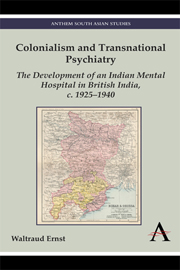 Colonialism and Transnational Psychiatry
Colonialism and Transnational Psychiatry Book contents
- Frontmatter
- Contents
- Acknowledgements
- Abbreviations
- Tables and Figures
- Introduction
- Chapter 1 Indianisation and its Discontents
- Chapter 2 The Patients: The Demographics of Gender and Age, Locality, Occupation, Caste and Religion
- Chapter 3 Institutional Trends and Standardisation: Deaths, Diseases and Cures
- Chapter 4 Classifications, Types of Disorder and Aetiology
- Chapter 5 Treatments
- Conclusion
- Notes
- Bibliography
- Index
Chapter 2 - The Patients: The Demographics of Gender and Age, Locality, Occupation, Caste and Religion
Published online by Cambridge University Press: 05 March 2014
- Frontmatter
- Contents
- Acknowledgements
- Abbreviations
- Tables and Figures
- Introduction
- Chapter 1 Indianisation and its Discontents
- Chapter 2 The Patients: The Demographics of Gender and Age, Locality, Occupation, Caste and Religion
- Chapter 3 Institutional Trends and Standardisation: Deaths, Diseases and Cures
- Chapter 4 Classifications, Types of Disorder and Aetiology
- Chapter 5 Treatments
- Conclusion
- Notes
- Bibliography
- Index
Summary
Knowledge linked to power, not only assumes the authority of ‘the truth’ but has power to make itself true.
—Michel Foucault, 1975One of the most pertinent questions in relation to any mental hospital is: who were the people who ended up in it? Who were they prior to becoming ‘patients’ with a particular diagnosis attached to them? Were they ‘village idiots’ and ‘half wits’, as is often assumed; ‘the morally disreputable, the poor, and the impotent, […] vagrants, minor criminals, and the physically handicapped’, as the sociologist Andrew Scull suggested in 1979 for the period prior to the mid-nineteenth century in England?1 Or were they dangerous psychopaths, religious fanatics and ‘mad axmen’, as many fear when they hastily walk past a mental institution? Were the inmates merely somewhat strange ‘eccentrics’ who had developed the Indian version of the British colonials’ ‘doolally tap’ syndrome where they went ‘pagal’ (‘mad’)? Were they just a mixed bag of inconvenient family members and depressed women, political rebels, uncooperative Indian princes or intractable tribals who were locked away?
Evidence for each of these characterisations can be found in hospital records and medical, official and patient accounts all over the world. Sociohistorical analyses that set themselves apart from previously preferred ‘Whig’ narratives that celebrated the progress of biomedicine in Western science-based psychiatry have tended to focus on mental institutions as means of social, political and gender control, where formerly autonomous people were forced into the role of the ‘passive patient’.
- Type
- Chapter
- Information
- Colonialism and Transnational PsychiatryThe Development of an Indian Mental Hospital in British India, c. 1925-1940, pp. 27 - 66Publisher: Anthem PressPrint publication year: 2013


